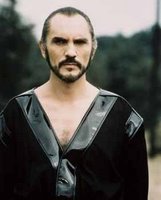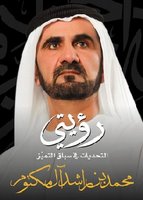 From certain angles, Sheikh Mohammed bin Rashid Al Maktoum, the ruler of Dubai, looks like a slightly more benign version of Superman II's grim-visaged General Zod, desirous of world domination. This could be one reason why I'm alarmed by Dubai's transparent efforts to become the world's ultimate tourist destination: to be bigger, showier, more eye-popping than anyplace else; to be all things to all people, with every sort of landscape within arm's reach (we have beach resorts! and mountain ranges! and desert camps! and fancy cruises! and cavernous, country-themed malls rubbing shoulders with
From certain angles, Sheikh Mohammed bin Rashid Al Maktoum, the ruler of Dubai, looks like a slightly more benign version of Superman II's grim-visaged General Zod, desirous of world domination. This could be one reason why I'm alarmed by Dubai's transparent efforts to become the world's ultimate tourist destination: to be bigger, showier, more eye-popping than anyplace else; to be all things to all people, with every sort of landscape within arm's reach (we have beach resorts! and mountain ranges! and desert camps! and fancy cruises! and cavernous, country-themed malls rubbing shoulders with  heritage villages! and even a skiing slope, the only one in the Middle East). The staggering World archipelago project, currently under construction off the coast, is like a giant symbol for what the city wants to be.
heritage villages! and even a skiing slope, the only one in the Middle East). The staggering World archipelago project, currently under construction off the coast, is like a giant symbol for what the city wants to be. It isn't enough to merely be the biggest or shiniest for now; safeguards must be set in place for the future too. A tour guide tells us that the Burj Dubai, proposed to be the world's tallest building, is being put together in such a way that the top can be extended – "so if some other country makes an equally tall structure, we can increase the size of this one to maintain our position". This is fairly representative of the attitude of Dubai's planners. Give no one else a chance.
Everywhere you go, you see signs proclaiming future glory. Impressive as parts of the city already look (if you're impressed by large glass-and-concrete structures, that is), Dubai is apparently only 20 per cent complete at this point. Given the pace of construction – one-sixth of the world's cranes are currently in or around the city, and working round the clock – the remaining 80 per cent should be finished quite soon. It's easy to see the reason for the haste. Dubai's petroleum reserves will be exhausted in less than 10 years' time. By then, the idea is that the city won't need the oil – all the money will come in from tourism.
The building that houses the Dubai Tourism and Commerce Marketing (DTCM) office resembles a pregnant woman, with a few of the middle floors jutting out from the rest of the structure. This is bizarrely appropriate, for more than anything else Dubai gives the impression of being perpetually in labour, straining to produce one of the great metropolises-cum-tourist centres. It remains to be seen whether that happens or whether this gestation period produces a monster-child incapable of sustaining all the infrastructure, with the already-considerable gap between the rich and the poor widening even further.
An interesting fact about the Emirates is that each Emirate runs pretty much independently with its own airlines etc. For years, Abu Dhabi and Dubai competed with each other and now Dubai has managed to overtake the capital city in its grandiosity, with its meticulous planning. Though, AUH does try to compete still with its gold-inlaid Emirate Palace hotel as its competition to the dhow shaped Burj Al Arab.
ReplyDeleteWonder what Dubai will do in ten years time, if tourism does not really take off as planned and does not generate enough income to sustain the expensive standard of living.
Hey Jai, I know everyone that goes to Dubai always talks about their architecture and all the real estate that's going on there. Out of curiosity, what about the grandiosity of the mosques? Is anyone planning to trump the Taj Mahal over there?
ReplyDeleteif you ask me, i think they've made a serious mistake by forgetting about the average traveller or the backpacker with a shrinking pocket. there are nil budget flights, flights from here are overpriced and there are absolutely zero backpacker facilities for the thousands who prefer to travel this way.
ReplyDeletesometimes, being the biggest and shiniest is not the way to win the heart of a traveller. it'll be interesting to see how Dubai will sustain itself in 20-50 yrs time.
@Anangbhai: u gave them an idea!
ReplyDelete@ Dali: kadka flying, air arabia